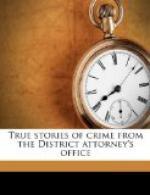The Assistant District Attorney complained that this was clearly a contempt of court, particularly as the defendant had drawn a picture not only of himself, but of the presiding justice and a witness, which had appeared in one of the evening papers. The Court, however, did not see that anything could be done about it and the girl openly continued her literary and artistic recreation. The Court itself was not a little amused at the actions of the defendant, and when Detective Peabody was called to the stand the general hilarity had reached such a pitch that he was unable to give his testimony without smiling. The natural result, therefore, at the first trial, was that the detective succeeded in giving the unqualified impression that he was drawing the long bow in a most preposterous fashion.
At the conclusion of the People’s case the evidence that Mrs. Parker had forged the checks amounted simply to this: That an officer who was greatly interested in her conviction had sworn to a most astonishing series of facts from which the jury must infer that this exceedingly astute young person had not only been entirely and completely deceived by a detective, but also that at almost their first meeting she had confessed to him in detail the history of her crimes. Practically the only other evidence tending to corroborate his story were a few admissions of a similar character made by her to newspaper men, matrons and officers at the police station. Unless the jury were to believe that Mrs. Parker had actually written the signatures on “the Peabody sheet” there was no evidence that she was the actual forger; hence upon Peabody’s word alone depended the verdict of the jury. The trouble with the case was that it was too strong, too good, to be entirely credible, and had there been no defense it is exceedingly probable that the trial would have resulted in an acquittal, since the prosecution had elected to go to the jury upon the question of whether or not the defendant had actually signed the checks herself.
Mrs. Parker, however, had withdrawn her plea of insanity and determined to put in a defense, which proved in its turn to be even more extraordinary than the case against her. This, in brief, was to the effect that she had known Peabody to be a police officer all along, but that it had occurred to her that if she could deceive him into believing that it was she herself who had committed the forgeries her husband might get off, and that later she might in turn establish her own innocence. She had therefore hastily scratched her name on the top of a sheet already containing her husband’s handwriting and had told Peabody that the signatures had been written by herself. That the sheet had been written in the officer’s presence she declared to be a pure invention on his part to secure her conviction. She told her extremely illogical story with a certain winsome naivete which carried an air of semi-probability with it. From her deportment on the stand one would have taken her for a boarding school miss who in some inconsequent fashion had got mixed up in a frolic for which no really logical explanation could be given.




